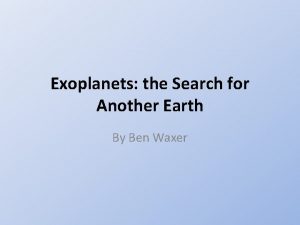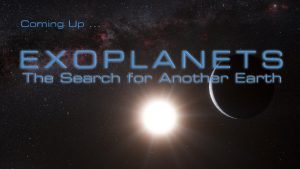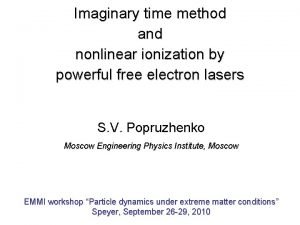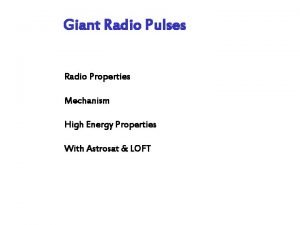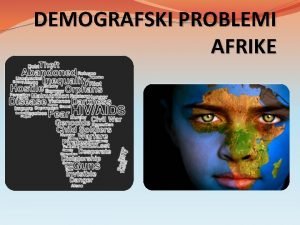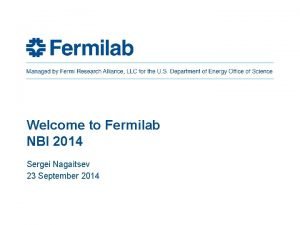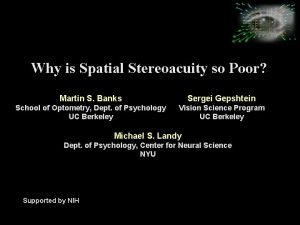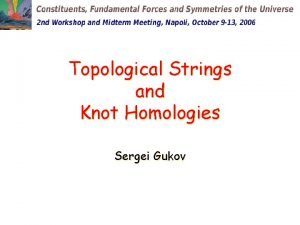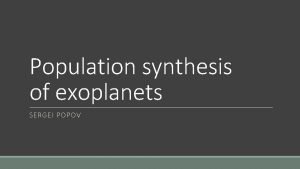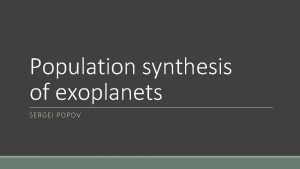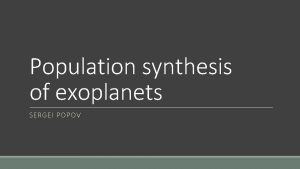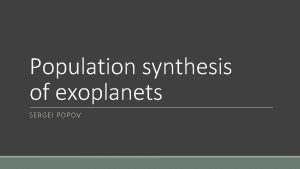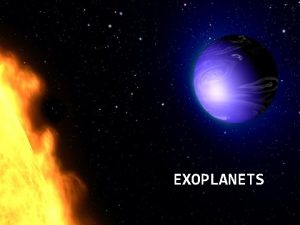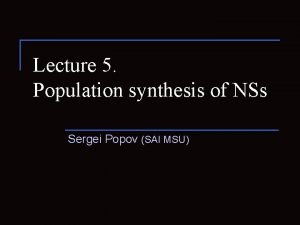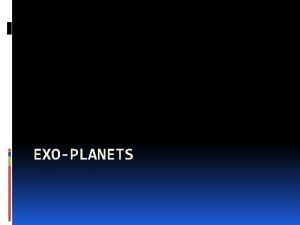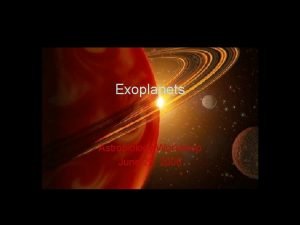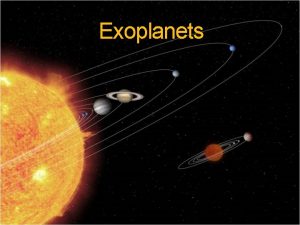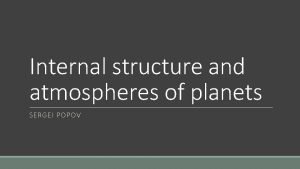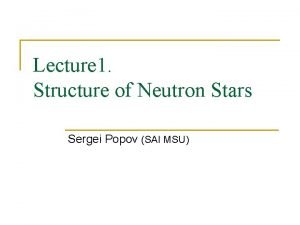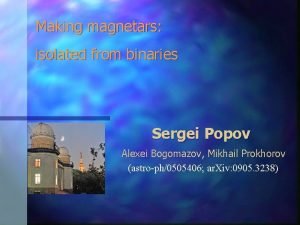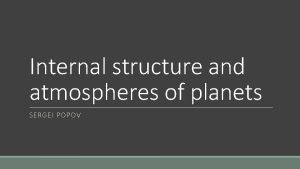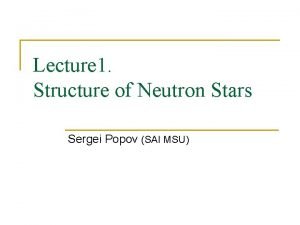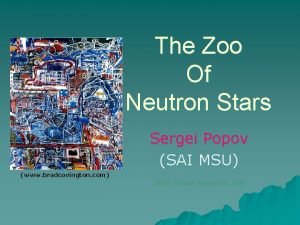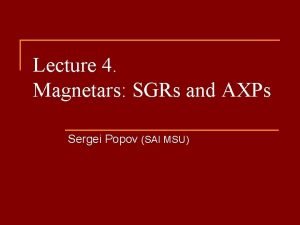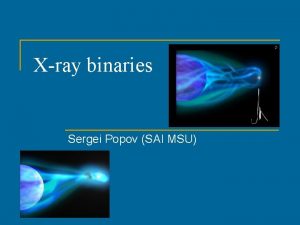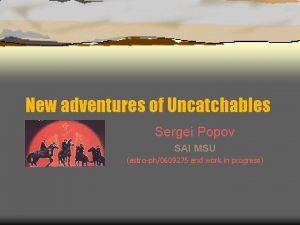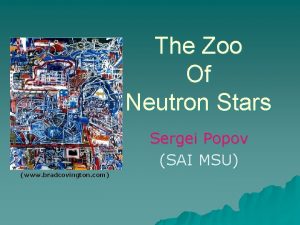Population synthesis of exoplanets SERGEI POPOV Population synthesis





















- Slides: 21

Population synthesis of exoplanets SERGEI POPOV

Population synthesis in astrophysics A population synthesis is a method of a direct modeling of relatively large populations of weakly interacting objects with non-trivial evolution. As a rule, the evolution of the objects is followed from their birth up to the present moment. Evolutionary and Empirical 1. Evolutionary PS. The evolution is followed from some early stage. Typically, an artificial population is formed (especially, in Monte Carlo simulations) 2. Empirical PS. It is used, for example, to study integral properties (speсtra) of unresolved populations. A library of spectra is used to predict integral properties. astro-ph/0411792

Ingredients: - initial condition - evolutionary laws «Artificial observed universe» Modeling observations «Artificial universe»

1402. 7086

The first PS model for exoplanets Authors modeled formation and migration (I&II) of exoplanets in order to reproduce so-called “desert” in mass-semi-major axis distribution (masses 10 -100 Earth mass, and a<3 AU). Main ingredients: • Disk model; • Accretion model; • Migration model. The rate of type I migration was significantly reduced to avoid rapid planet displacement. Red- giants; green – rocky; blue – ice. Ida, Lin astro-ph/0312144

Individual tracks Green - rock Red - gas Blue - ice C 1 = 0. 1; fd, 0=2 Ida, Lin 2013

Mordasini et al. models Mordanisi et al. published a series of papers (0904. 2524, 0904. 2542, 1101. 0513, 1201. 1036) on population synthesis of exoplanets, using an approach generally similar to the one by Ida, Lin. Then this studies were continued in 1206. 6103, 1206. 3303, 1708. 00868. A review is given in 1402. 7086. An important step is too include planet-planet interactions. A separate subject is to follow long-term evolution. 0904. 2524

Mass – semi-major axis distribution Alibert et al. (2013) 1402. 7086 Ida, Lin (2013)

Mass distribution It is still not absolutely clear, if the so-called “planetary desert” exist or not. 1402. 7086

Comparison with observations Observations Calculations for observable planets (Porb<10 yrs; v>1 m/s) Calculations Ida, Lin (2013) 1402. 7086

Metallicity effect Solid line – all stars. Dashed line – stars with at least one giant planet. Dotted line – stars with at least low-mass planet. 1402. 7086

Composition Formation and evolution model allows to estimate the bulk composition of planets. 1402. 7086

Another way to form planets Gravitational instability in the outer parts of the disc. Lucio Mayer & T. Quinn Allows to form massive planets out to few tens AU. Might also work for brown dwarfs and very light stars. Some new results in 1711. 05948

Tidal downsizing Fragment mass just after fragmentation Hypothesis by Nayakshin (2010). It is possible to make solid planets at low orbits Hill radius becomes smaller as a planet migrates towards the star. Evolution of a fragment is a disc can result in appearance of a low-mass planet closer to the star, or in appearance if a belt of particles. 1304. 4978

Initial and final semi-major axis distribution 1304. 4978

Mass and semi-major axis distribution 1304. 4978

Mass distribution and planet types Many brown dwarfs (and even low-mass stars for some parameters) can be produced via this channel. 1711. 01133

Role of fragment-fragment interaction Interaction off 1711. 01133 Interaction on

Ejection Many fragments are ejected. So, this mechanism of planet formation can be an important contributor to the population of free-floating planets and brown dwarfs. 1711. 01133

System architecture Typical systems 1711. 01133 Non-typical systems

Literature • 1402. 7086 Planet Population Synthesis W. Benz et al.
 Exoplanets the search for another earth
Exoplanets the search for another earth Exoplanets the search for another earth download
Exoplanets the search for another earth download Popov
Popov Tamara popov
Tamara popov Popov
Popov Andrew popov
Andrew popov Jurij popov
Jurij popov Aleksa popov
Aleksa popov Dmitry popov tenor
Dmitry popov tenor Sergei nagaitsev
Sergei nagaitsev Sergei komarov contact info
Sergei komarov contact info Sergei sedov
Sergei sedov Francys arsentiev
Francys arsentiev July 1969
July 1969 Sergueï dyadechko fortune
Sergueï dyadechko fortune What of this goldfish would you wish
What of this goldfish would you wish Sergei gepshtein
Sergei gepshtein Sergei naryškin
Sergei naryškin Sergei gukov
Sergei gukov Population ecology section 1 population dynamics
Population ecology section 1 population dynamics Chapter 4 section 1 population dynamics study guide
Chapter 4 section 1 population dynamics study guide Population ecology section 1 population dynamics answer key
Population ecology section 1 population dynamics answer key
